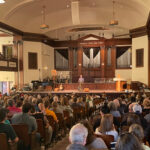I remember when RGIII began.
I was a Baylor graduate pastoring a church in Waco, Texas. Baylor’s football program was on its fourth coaching staff in a decade, and Art Briles had the unpleasant task of trotting out the annual hype machine to help drum up season ticket sales. The pitch was something like, “Just wait till you see this Robert Griffin kid play.” I had heard several variations of this pitch before. Kevin Steele gave us Greg Cicero. Guy Morris gave us Shawn Bell. Both QBs were good players. Neither got us to a bowl game. And like many in the Waco area, I had given up.
Then 2008 happened, and Robert Griffin became RGIII. Just watch highlights of RGIII vs. Wake Forest. On the field, he displayed the promise and substance of his athletic ability. Off the field, he quietly demonstrated leadership, character, and smarts. Wacoans rejoiced in their local legend—whenever he worshiped at David Crowder’s University Baptist Church, or strolled into the campus Wendy’s, or answered media questions about religion by shifting the conversation to his relationship with Jesus Christ.
Broad Coverage
I could tell lots of RGIII stories from a Baylor insider’s perspective. But now I don’t have to thanks to Ted Kluck’s Robert Griffin III: Athlete, Leader, Believer. Kluck hits readers with impressions of Griffin through a series of thematically organized, journalistically styled chapters on Griffin’s life, faith, and approach to leadership on and off the field. What Kluck lacks in organizational complexity, he makes up for in breadth of coverage. Kluck opens with a look at Griffin’s upbringing as the strongest explanation for RGIII’s success. Robert was raised by “little league parents” who just so happened to be retired Army drill sergeant disciplinarians in a football-obsessed small town that valued star athletes above all else. Griffin benefited from the football pipeline in Texas, which drove him to the quarterback-friendly Big 12 Conference, which beget a straight-shot pathway to the National Football League.

Robert Griffin III: Athlete, Leader, Believer
Ted Kluck
Griffin’s backstory leads Kluck to a thesis: Griffin is not merely some freak athlete, who through happenstance discovered a lucrative career in professional sports. On the contrary, Griffin has been internally driven to be a successful quarterback from a young age and “worked like an animal and engineered his life so that it would turn out pretty much exactly the way that it’s turned out so far” (5). Consider the following: Griffin set and achieved his goals of being an all-state football player, a high school all-American in track, and class president of his senior class, graduating number seven out of more than 500. He wanted to finish Baylor in three years, so he did, graduating summa cum laude with a degree in political science and earning early admission into Baylor Law School. He wanted to be an all-American and Olympic qualifier in college track and field. Check. Heisman Trophy? Check. College football all-American? Check. And with this impressive list of accomplishments, Kluck discovers one of the most cerebral, devoutly Christian, high-character, disciplined, focused, driven, goal-oriented, freakishly athletic QBs to ever enter the NFL. And Griffin has become this kind of person by his own design, hard work, parental guidance, church participation, and a few lucky breaks here and there.
The rest of Robert Griffin III covers little new ground with the exception of two insightful chapters. Kluck offers a unique perspective on Griffin’s media savvy in chapter 4 and wades into the “God in football” debate in chapter 10. In terms of selling RGIII to the masses, Kluck observes an athlete who has worked diligently to build his brand as the ordinary athlete in stark contrast to the consummate demigod professional model of Michael Jordan. Like Jordan, this approach serves to make RGIII an effective pitchman as the unique voice of the ordinary athlete within an industry of alpha-male pitchmen. Unlike Jordan, Griffin is accessible, whether tossing sandwiches at Subway, drinking Gatorade, wearing goofy socks, or being a normal, good-guy athlete.
Kluck waits until chapter 10 to address the God issues. Here, Kluck reveals some of his prolegomena preferences, dismissing quarterbacks like Tim Tebow and Jon Kitna as too evangelistic in their brand and praising Griffin’s more measured piety and restrained evangelism. In a curious move, Kluck associates retired quarterback Kurt Warner not with Tebow, but with Griffin. Kluck observes that Warner began in the NFL as a young and irresponsible apologist who, over time, learned to keep his Jesus language more casual. Kluck sees Griffin picking up this mantle of piety, while also incorporating a Joel Osteen-like positive Christianity into his worldview.
Fascinating Figure
If readers are looking to Robert Griffin III for devotional thoughts, Christian inspiration, or missionary biography, they will be disappointed. Kluck provides a thin description of Griffin’s belief in Jesus—about which Griffin is intentionally private. Kluck also protects his narrative from becoming a juxtaposition of famous Jesus-believing quarterbacks such as RGIII, Tebow, and Roger Staubach.
But Kluck does offer a Christian reading audience insight into the makeup and drive of a fascinating sports figure in 21st-century America. Readers may not be able to learn from Griffin’s theology or piety, but they will come away with a tangible expression of a manhood that values responsibility, discipline, intelligence, hard work, noble character, and leadership.

































